Article by Jeanne Connolly Thinking about a career in Landscape Architecture ? Are the years of studying, research, and projects worth it? Yes! And this is why it will pay off! As we move into a future of sustainability and the need for energy-efficient resources, landscape architecture has become a key to the future of design. Trained with a wide range of skills that combine art and science, the opportunities are endless for landscape architects. With a creative eye and environmental awareness, landscape architects design to improve everyday life. Still wondering if landscape architecture is right for you? Or need more assurance that you are going in the right direction? Maybe these 10 reasons will make you more confident with choosing landscape architecture!
Career in Landscape Architecture
1. Creative Career Path
Creativity pushes us to think and work without boundaries, in turn creating endless solutions and more productive thinking. Good design requires a lot of creativity, thought, and several solutions before you find “the one.” As a landscape architect you will keep your creative mind running throughout your entire career. To boost creativity, landscape architects also collaborate with one another and even other design fields such as architecture and engineering, adding the benefit of several different ideas.

Photo Credit: RO&AD This creative solution for the Raveijn Bridge by RO&AD is designed to adapt to climate changes. The floating bridge rises and falls in accordance with the changing water levels.
2. Versatile
From urban design to interior landscapes, landscape architects are trained with a wide range of knowledge that gives them several different areas of employment opportunity. The design is not the only important aspect of landscape architecture either. Research, data analysis, planning, and management are all important areas of expertise as well as aesthetics. As a landscape architect you could find yourself working in any of these areas: parks and recreation, urban design, residential design, hospitality and resorts, educational campuses, therapeutic gardens, wildlife reserves, conservation, historic preservation, commercial design, land art, interior landscapes, monuments, and much more. Related Article: 10 Niches you can Carve out of Landscape Architecture to Make a Name for Yourself
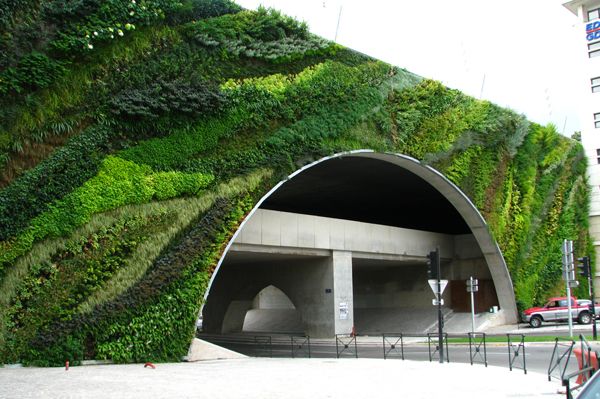
Photo Credit: Patrick Blanc Landscape Architects also combine different elements such as structure and planting design, as seen in this Green Wall.
3. Variety of Mediums
Landscape architects use about every form of creative media, from hand drawing to digital rendering. There is room for all artistic skills whether you specialize in working with your hands or your computer mouse. Related Article: Is Drawing a Natural Talent?

Photo Credit: Tino Beck A skillful combination of photography and hand rendering by Tino Beck. Featured in Sketchy Saturday | 32
4. Design for Healthier Lives
The landscape architecture practice follows the ASLA Board of Trustees’ “ASLA Code of Environmental Ethics” on asla.org, in which the preamble states, “Members of the American Society of Landscape Architects should make every effort within our sphere of influence to enhance, respect, and restore the life-sustaining integrity of the landscape for all living things.” Landscape architects strive to not only create intriguing places, but healthier environments for the general public. In Peter James and his cohorts’ study, “Exposure to Greenness and Mortality in a Nationwide Prospective Cohort Study of Women” in Environmental Health Perspectives, they linked residential greenness and mortality rates. They found the cumulative average seasonal greenness around 108,630 women’s addresses using data from US-based Nurses’ Health Study prospective cohort and satellite imagery from Normalized Difference Vegetation Index (NDVI). Related Article: 5 Top Health Benefits of Landscape Architecture
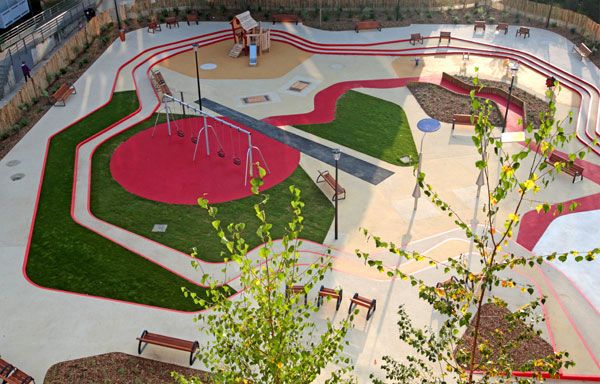
Photo Credit: Espace Libre A Toddlers Playground in Alfortsville, France, was designed to stimulate creativity for children in their early years of learning development.
5. Designing With Natural Elements
The use of plants as a material differentiates landscape architecture from other design areas and the combinations are endless. Material selection is also based on environmental impact along with aesthetics. Landscape architects take what is natural and design solutions that are both creative and environmentally beneficial. Related Article: 10 Projects That Make Excellent use of Planting Design
6. Historic Preservation
The cultural experience of a place roots deep in its history. Preserving that history is very important in keeping community culture alive. Through each project, landscape architects research heavily into the history of their site, and make sure to preserve and elaborate on what should not be left behind. Related Project:The Lakewood Garden Mausoleum by: HGA Architects

Photo Credit: Paul Crosby A modern approach to preserving the Lakewood Garden Mausoleum.
7. Wildlife Conservation
For the animal lovers, conserving and protecting wildlife is an important part of landscape architecture. Not only on wildlife reservations, but in almost all projects, landscape architects use conservation design practices, thoughtful plant palettes, and a lot of research to conserve and create wildlife habitats. Related Project: Reflecting on the Past While Looking Forward to the Future With Wildlife Conservation
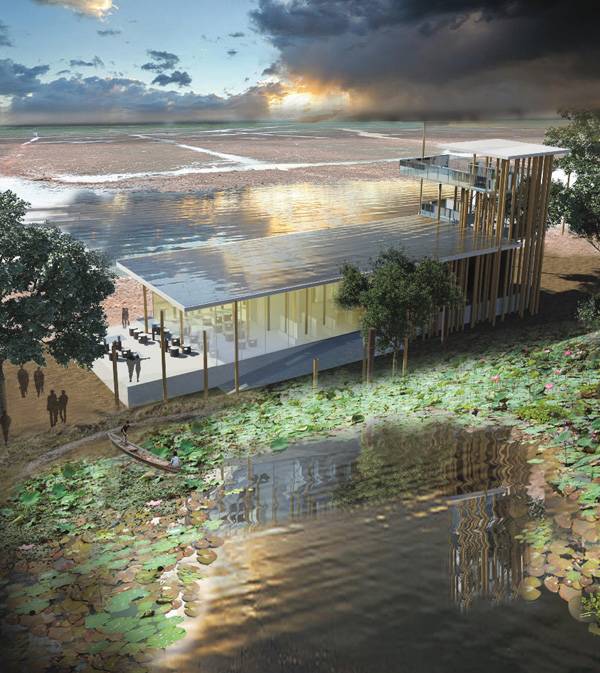
Photo Credit: And Trapeang Thmor Memorial Crane Reserve Press Release Building Trust International and the Wildlife Conservation Society (WCS) collaborated on an interpretation centre at Ang Trapeang Thmor Wildlife Reserve.
8. Sustainable Design
As climate change has already begun, it has become a prominent issue that design must adapt to. By using sustainable solutions, landscape architects intend to combat climate change and create environmental solutions that last years into the future. Sustainable solutions that landscape architects design include: green roofs, storm water management, rain water harvesting, rain gardens, etc. Related Project: Copenhagen’s First Climate Resilient Neighborhood
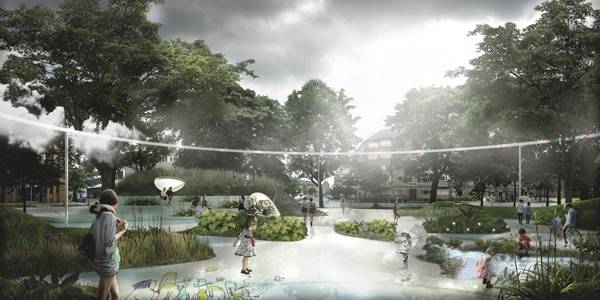
Photo credit: tredjenatur.dk Storm water management practices are used to fix the flooding problem in St. Kjeld, Osterbro.
9. Community Involvement
Landscape architects create people-oriented design that speaks to the community and improves their experience. Landscape architects are often involved in town hall meetings and public surveys in order to find out what the community actually wants and needs. It gives you a chance to get involved with the community and make an impact on their outdoor experience. Related Project: How Mesa City is Giving us a Great Lesson in Public Participation
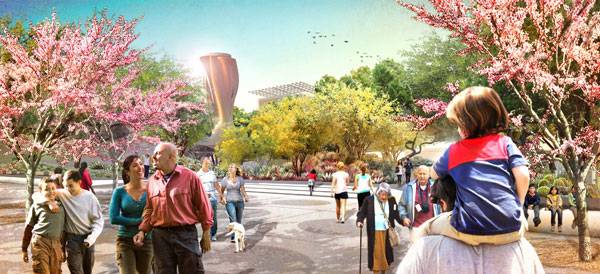
Photo credit: Colwell Shelor, West 8, Weddle Gilmore A public landmark in Mesa City designed to increase the quality of pedestrian life.
10. Relatable to Everyone
From the minute you walk out the door in the morning, you are experiencing landscape architecture. Some of our most memorable experiences have to do with a certain place or view outside. It is more than the design of spaces, but designing places of experience that people can relate to globally.
Are you up for the Challenge of a Career in Landscape Architecture ?
Landscape architecture combines art and science to improve not only the environment, but our everyday lives. You have the opportunity to make an impact on the world’s experience of outdoor spaces as a landscape architect, and have endless ways and places to do so. It’s only up to you now. Are you up for the challenge?
Recommended Reading:
- Becoming an Urban Planner: A Guide to Careers in Planning and Urban Design by Michael Bayer
- Sustainable Urbanism: Urban Design With Nature by Douglas Farrs
Article by Jeanne Connolly
Published in Blog

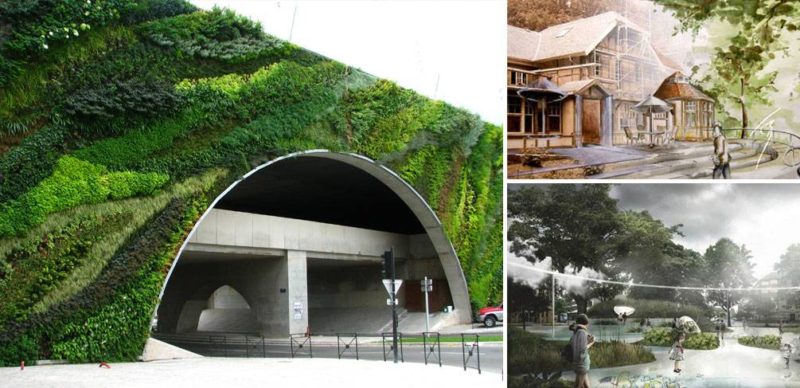






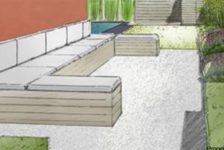


Pingback: 5 Reasons Every Architect Should Study Landscape and Interior Design – Charles Lubbat Swimming Pool Design Consultancy
Pingback: Landscape Architecture Career - Home Floor Plans Architecture Ideas
Pingback: How Do You Interview A Landscape Designer? – Sarahjocrawford
Pingback: What Challenges Do Landscape Architects Face? – Sarahjocrawford
Pingback: What Is The Formal Outline Of Becoming A Landscape Architect? – Fallsgardencafe